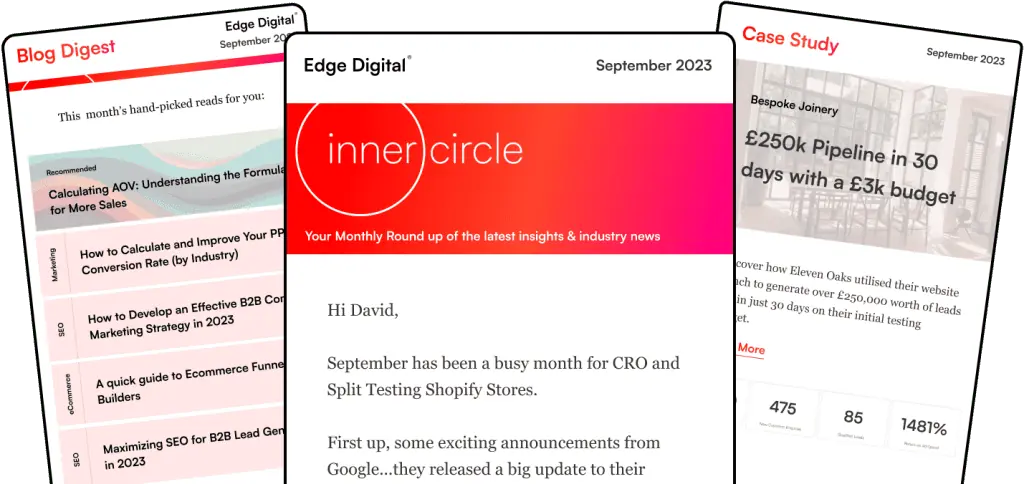Understanding competitor ads can give us a significant edge in the advertising world. By conducting a thorough competitor ads analysis, we can spot trends, gaps, and opportunities.
Many tools and techniques help us keep an eye on competitor ads. From using the Facebook Ads Library to checking the Google Ads Transparency Centre, we have numerous ways to gather useful insights.
These platforms show us what kind of ads our competitors are running, their messaging, and the target audience they’re aiming for.
Monitoring ads isn’t just about copying what others do. It’s about understanding the market and making informed decisions to position our brand better.
Whether it’s through social media or search engines, knowing what our competitors are doing helps us refine our campaigns and ensure we stay ahead.

knowledge is key when it comes to competitor ads
Key Takeaways
Analysing competitor ads reveals market trends and opportunities.
Tools like Facebook Ads Library help monitor competitor campaigns.
Using insights from competitor ads refines our advertising strategies.
Understanding Competitor Ads
Competitor ads, including competitors’ Google Ads, are a crucial part of marketing strategy. They offer valuable insights into industry trends and how competitors engage with their audience.
We will explore the essence of competitor analysis, key advertising metrics, and how to leverage industry insights effectively.
Essence of Competitor Analysis
Monitoring competitor ads helps us understand our market position. By examining our competitors’ ads, we gain insights into their strategies.
This involves looking at their ad copy, design, and audience targeting techniques.
Understanding these elements helps us identify strengths and weaknesses in their campaigns. This way, we can refine our strategies and stay competitive.
Regular analysis keeps us ahead and aware of market changes.
Key Metrics in Competitive Advertising
Key metrics in competitive advertising include Click-Through Rate (CTR), Conversion Rate, and Cost Per Click (CPC). Using tools like Google Ads Keyword Planner can help us understand CPC and other key metrics.
CTR measures how effective an ad is in getting clicks. Conversion Rate shows the percentage of clicks that lead to desired actions, such as purchases. Meanwhile, CPC tells us how much we pay for each click.
Monitoring these metrics helps us evaluate our own ads against competitors’. For instance, a high CTR but low conversion rate might indicate a problem with our landing page.
Regular tracking ensures our strategies remain effective.
Leveraging Industry Insights
Industry insights are essential to stay relevant. We can use tools like the TikTok Creative Center to analyse top ads and gain inspiration.
Observing trends in successful ads helps us adapt to changing market demands.
Benchmarking against top competitors keeps our strategies fresh and aligned with industry standards.
We can also identify emerging trends and capitalise on them early.
This proactive approach ensures our advertising efforts are always up-to-date and effective.
Developing a Robust Advertising Strategy
To develop a successful advertising strategy, we need to articulate a clear value proposition, allocate our budget effectively, and select the most effective advertising platforms. Analyzing competitors’ strategies can provide valuable insights for our own ad campaigns.
Crafting a Unique Value Proposition
A unique value proposition (UVP) is crucial in differentiating our brand from competitors. It should clearly convey the unique benefits of our products or services.
First, we must identify what sets us apart. This might be our product features, pricing, or customer service.
We should then communicate this distinctiveness succinctly in our ads.
Finally, using compelling visuals and taglines can enhance our UVP, making it memorable for our audience.
Budget Allocation for Optimal Reach
Proper budget allocation is key to maximising our advertising reach. We need to allocate funds strategically across different platforms to get the best return on investment.
We should start by understanding the cost-per-click (CPC) or cost-per-impression (CPM) rates on different ad networks like Google, Facebook Ads, LinkedIn Ads, and TikTok Ads.
Tracking the performance of our ads regularly helps us adjust the budget as required, focusing more on high-performing channels.
Additionally, we should reserve a portion of the budget for testing new ideas and platforms.
This ensures continuous improvement and innovation in our strategy.
Selecting Effective Advertising Platforms
Choosing the right advertising platforms is crucial to reaching our target audience effectively. Each platform has its strengths and caters to different demographics.
For example, Google Ads is excellent for search intent targeting, while Facebook Ads offers robust audience segmentation capabilities.
LinkedIn Ads are ideal for B2B marketing, and TikTok Ads can be very effective for reaching a younger audience with engaging video content.
By analysing our target audience’s behaviour and preferences, we can select the platforms that will provide the greatest impact.
Regular performance reviews will help us refine our choices, ensuring we invest in the platforms that deliver the best results.
Creative and Messaging

Create powerful creatives- stand out from the crowd and be recognised
Successful competitor ads depend on powerful ad creatives, compelling ad copy, and effective calls to action. Each component needs careful attention to ensure high engagement and conversion rates.
Designing Standout Ad Creatives
A standout ad creative catches the viewer’s eye immediately. It combines colours, imagery, and design elements that align with our brand identity.
We should study our competitors’ ad visuals on platforms like Google and TikTok, noting what works well.
High-resolution images or engaging videos can significantly improve engagement.
Incorporating our unique branding elements while being aware of trends ensures our ads are not just seen but remembered.
Highlighting benefits visually can make our message clearer and more attractive to our target audience.
Aligning Ad Copy with Messaging
Our ad copy must be clear and aligned with our brand’s messaging. This includes headlines, descriptions, and taglines that speak directly to our audience’s needs and wants.
We can learn from examining competitors’ successful ads, focusing on the tone and style they use.
Short, impactful sentences and compelling language can make our message more persuasive.
Moreover, consistently reflecting our brand voice across all ads can build stronger connections with our audience.
It’s essential to address their problems and offer unique solutions effectively.
Calls to Action and Conversion
A powerful call to action (CTA) drives the user to take the next step. This is crucial for converting interest into actions, like clicks or purchases.
We should look at what types of CTAs our competitors use and how these drive conversions.
Clear and direct phrases like “Buy Now”, “Sign Up Today”, or “Learn More” often perform well.
Testing different CTAs to find what resonates can improve conversion rates.
It’s important to ensure our CTAs are easy to spot and understand, guiding the user effortlessly to the desired action.
Target Audience and Segmentation

Get the most out of your advertising with identifying your target audience
In this section, we’ll explore how to effectively identify your target audience, tailor advertisements to niche markets, and utilise the available targeting options to personalise your campaigns for maximum impact.
Understanding Audience Demographics
Recognising the demographics of your target audience is crucial for effective marketing. Demographics include age, gender, location, education, and income levels.
By analysing these factors, we can better understand who our audience is and what they need.
For instance, younger audiences may prefer digital interactions, while older demographics might appreciate more traditional methods.
Understanding these traits helps in crafting messages that resonate more deeply with different segments.
This foundational knowledge enables us to create more precise and engaging campaigns.
Tailoring Ads to Niche Markets
Niche markets are specific subsets of a larger market defined by unique preferences, needs, or characteristics. These might include vegan consumers, tech enthusiasts, or eco-conscious buyers.
By tailoring ads to these niches, we can communicate more directly and effectively.
Personalisation in these ads, such as using relevant language or imagery, can significantly increase engagement.
For example, an ad targeting eco-friendly consumers might emphasise sustainability and environmental impact.
Focusing on these aspects ensures our message aligns closely with the values and interests of the niche audience.
Targeting Options and Personalisation
Facebook offers a variety of targeting options to enhance ad personalisation.
We can refine our approach by using filters like age, gender, interests, and behaviours through tools like the Audience tab in Business Suite insights.
This helps in creating highly customised and relevant advertisements.
Additionally, we can use website retargeting campaigns to reach users who have already interacted with our content.
By leveraging these options, we ensure our ads are shown to those most likely to engage. This, in turn, increases conversion rates and overall campaign effectiveness.

Using analysis and optimisation tools is key
Competitive Research and Tools
Understanding how our competitors run their ads is crucial for improving our own campaigns. Using these tools, we can monitor competitor ads to gain insights into their strategies. We can leverage various tools and insights to stay ahead in the competitive landscape.
Using Competitive Analysis Tools
To get started, we need to focus on tools specifically designed for competitive research.
For instance, Similarweb offers an all-in-one solution, allowing us to quickly gather data on competitors’ website traffic and performance.
SEMrush and SpyFu are excellent for keyword research, letting us discover the keywords our competitors are ranking for.
These tools highlight gaps in our content strategy and help us target high-performing keywords.
Additionally, SpyFu provides insights into our competitors’ PPC campaigns, letting us see their ad spending and strategies.
Ahrefs is another powerful tool that enables us to analyse competitors’ backlinks.
Understanding where competitors have secured backlinks helps us identify potential partnership opportunities.
Ahrefs also provides detailed insights into competitors’ content, helping us pinpoint what works well in our industry.
Integrating Third-party Insights
Third-party insights are invaluable when it comes to fine-tuning our strategy.
The Google Ads Transparency Center is a go-to resource for understanding the ads our competitors are running across Google’s platforms.
We can see which ads are performing well and adapt our strategies accordingly.
The Facebook Ad Library is another essential tool. It allows us to view all active ads by our competitors on Facebook and Instagram.
This insight can guide us in crafting compelling ads that resonate with our target audience.
Crayon offers AI-driven competitive intelligence. It compiles and organizes competitor updates automatically, ensuring we stay updated on our competitors’ latest moves.
Integrating these insights into our strategy helps us remain agile and responsive in a fast-paced market.
Benchmarking with Ad Transparency Features
Ad transparency features are critical for benchmarking our performance against our competitors.
Both the Google Ads Transparency Center and the Facebook Ad Library provide extensive information on active ads, targeting methods, and engagement metrics.
This data allows us to measure how well our ads perform in comparison.
For instance, if we notice a competitor’s ad getting significantly more engagement, we can analyze their approach and tweak our campaigns accordingly.
The transparency features help us identify industry trends and ensure our strategies align with current market demands.
Digital Advertising Channels
Digital advertising offers a wide range of channels for promoting products and services. These channels can be tailored for different audiences and goals, making them essential for modern marketing strategies.
Search Engine Marketing and SEO
Search Engine Marketing (SEM) and Search Engine Optimization (SEO) are crucial in the digital advertising landscape.
SEM involves paying for ads on search engines like Google, where our ads appear prominently when users search for specific keywords. These search ads are effective in driving targeted traffic to our website.
SEO, on the other hand, focuses on improving our website’s organic search rankings.
By optimizing content, using relevant keywords, and ensuring our site meets technical standards, we can increase our visibility without paying for each click.
Both SEM and SEO are essential for reaching users actively searching for our products or services.
The Role of Social Media Platforms
Social media platforms offer vast opportunities for digital marketing. Meta (Facebook and Instagram), TikTok, LinkedIn, and others allow us to create targeted ad campaigns that reach specific demographics.
On Meta, we can use detailed audience targeting and ad formats like carousel ads and video ads to captivate our audience.
TikTok’s algorithm can boost viral content, making it ideal for brand awareness campaigns. LinkedIn is particularly effective for B2B advertising, as it connects us with professional audiences through sponsored content and InMail ads.
By leveraging these platforms, we can engage users where they spend a significant amount of their time online.

Social media is one of the best avenues when it comes to advertising
Exploring B2B Advertising Networks
B2B advertising networks are specialized channels for targeting business customers.
LinkedIn stands out here, offering precise targeting based on job titles, industries, and company sizes. This allows us to tailor our ads to decision-makers and influencers within businesses.
Other B2B platforms include Google Display Network, where we can place banner ads on industry-specific websites.
These networks help us reach a professional audience efficiently, ensuring our marketing efforts are seen by those who are most likely to need our products or services.
Leveraging B2B networks is critical for building business relationships and generating qualified leads.
Optimizing Ad Campaigns
Effective ad optimization requires tracking performance, refining keyword research, and avoiding common mistakes.
By focusing on these areas, we can enhance our ad campaigns and achieve better results.
Tracking and Improving Ad Performance
Monitoring ad performance is crucial. We need to look at key metrics such as click-through rates (CTR), conversion rates, and return on ad spend (ROAS).
Using tools like Google Analytics can help us track these aspects effectively.
We should set clear goals and regularly review our ad metrics. This allows us to identify underperforming ads and make necessary adjustments.
For instance, if an ad has a low CTR, we might need to improve its headline or call-to-action.
A/B testing different ad variations can help us see which version performs best. This way, we can refine our approach and allocate our budget more effectively, ensuring higher returns on our ad spend.
Keyword Research and Targeting
Keyword research is fundamental for any successful ad campaign.
It’s important to find the right keywords that our target audience is searching for. Tools like Google Keyword Planner can be invaluable for this purpose.
We should focus on both short-tail and long-tail keywords. Each type has its benefits; short-tail keywords may attract more traffic, while long-tail keywords can bring in more targeted customers.
It’s also critical to regularly update our keyword list based on performance data.
Negative keywords are also essential. By excluding irrelevant keywords, we can avoid wasting budget on unqualified clicks. This helps in improving the overall efficiency of our ad campaign.
Avoiding Common Mistakes
One common mistake is not setting a clear budget. Without proper budget allocation, we can overspend or underspend, impacting the efficacy of our campaigns.
Setting daily or monthly budgets helps keep our spending in check.
Another mistake is neglecting ad copy. Poorly written ads can fail to attract clicks or conversions.
We should ensure our ads are compelling, relevant, and include a strong call-to-action.
Not using ad extensions can also be a missed opportunity. Extensions like site links or callouts can make our ads more informative and increase their visibility.
By avoiding these mistakes and continually refining our strategies, we can greatly improve the performance of our ad campaigns.
Market Positioning and Competition
In today’s competitive landscape, understanding our market positioning and the actions of our competitors is crucial.
We can leverage our strategic advantage, monitor competitive pricing, and identify gaps to maintain a strong market presence.
Strategic Advantage and Market Trends
Knowing our strategic advantage helps us stand out.
By analyzing current market trends, we identify what sets us apart. This includes unique selling points like product features, customer service, or brand reputation.
Tracking trends ensures we keep up with shifting customer preferences.
For example, the rise of TikTok ads shows a shift towards short, engaging content. Staying updated allows us to adapt our strategies effectively.
We must also remain vigilant about our competitors. Regular analysis of their marketing tactics and innovations can provide insights into emerging opportunities.
Competitive Pricing and Offers
Competitive pricing is essential for staying relevant.
We need to regularly review and adjust our pricing strategies to match or undercut our rivals without compromising on quality.
Examining competitors’ offers and promotions helps us craft appealing deals.
For example:
CompetitorProductPriceSpecial OfferBrand AWidget£5010% offBrand BGadget£45Free shipping
Keeping track of your competitors prices is a great way to make sure you are getting in front of potential customers.
Our goal is to offer better value while sustaining profitability.
We can also explore bundling products, loyalty programs, and time-limited discounts to attract customers.
Identifying Gaps in the Market
Finding and exploiting gaps in the market enables us to capture untapped potential.
By conducting thorough market analysis, we can identify unmet needs or under-served segments.
For instance, we may discover a growing demand for eco-friendly products that competitors have overlooked. Introducing a sustainable product line positions us to fill this gap.
Additionally, analyzing feedback and reviews unveils areas where competitors fall short. This provides opportunities to improve our offerings and differentiate ourselves.
By addressing these gaps, we can enhance our market position and attract new customers.
Measuring Success
To measure the success of our competitor ad strategy, we need to focus on auction insights reports, conversion rates, and the overall user experience.
Using these tools and metrics will help us fine-tune our campaign and ensure it meets our goals and benchmarks.
Utilizing Auction Insights Reports
Auction Insights Reports play a crucial role in understanding how our ads perform against our competitors.
These reports provide detailed data on our ad’s top-of-page rate, impression share, and average position.
By examining Auction Insights, we can identify areas where we can improve our bids and targeting.
For instance, if our top-of-page rate is lower than a competitor’s, it suggests we need to increase our bids or refine our targeting to increase visibility.
Additionally, we can use auction insights to determine if competitors are outranking us for certain keywords.
This information helps us adjust our keyword strategy to stay competitive. In essence, these reports ensure we stay informed and agile in our ad approach.
Analyzing Conversion Rates and Click-through Rates
Conversion rates and click-through rates (CTRs) are pivotal metrics when evaluating ad success.
Click-through rate measures the percentage of people who clicked on our ad after seeing it. A high CTR indicates that our ad is engaging and relevant to the audience.
Conversion rate, on the other hand, tells us how many of those clicks led to a desired action, such as a purchase or sign-up.
To boost conversion rates, we need to ensure our landing pages are compelling and trustworthy.
We should constantly test different ad copies and creative approaches to see which ones yield higher CTRs and conversions.
Tracking these metrics closely allows us to make informed changes that optimize our ad campaigns.
The Importance of User Experience
User experience (UX) is fundamental to ad success. Even the most enticing ads can fail if they lead to a poor user experience.
Keeping users engaged after they click on our ad is vital.
Firstly, ensure the landing page loads quickly. Slow-loading pages can frustrate users and increase bounce rates.
Secondly, maintain a clear, easy-to-navigate layout with a strong call to action (CTA) that directs users towards converting.
Lastly, the landing page should match the ad’s promise. Consistency between the ad content and landing page content builds trust and encourages conversions.
By focusing on UX, we enhance our chances of converting ad visitors into loyal customers.
Frequently Asked Questions
In this section, we will address common questions about analyzing competitor advertisements. We will discuss effective methods, tools, and strategies for identifying and understanding competitors’ advertising efforts.
How can one conduct a comprehensive analysis of competitors’ advertisements?
To conduct a comprehensive analysis, we should look at the ad copy, imagery, and call-to-action.
It’s important to review both the messaging and the design. Tracking how often certain ads appear can give us insights into ad spend and targeting strategies.
What methods are effective for identifying competitors’ advertisements on Facebook?
We can use Facebook’s Ad Library to view active ads from any brand.
Performing searches with relevant industry keywords and examining the creative, messaging, and audience targeting used by competitors is crucial. This helps us understand their strategies and potentially uncover gaps in the market.
What tools are available for discovering competitors’ display advertisements at no charge?
Free tools such as Google Ad Preview Tool and SEMrush offer insights into display advertisements. These tools allow us to see how often ads appear across the web. They also help us gather competitive intelligence without cost.
In what ways can you spy on your competitors’ advertising strategies?
We can monitor competitors’ ads by performing regular searches using relevant keywords and noting which ads consistently appear. Another way is utilising tools like Ahrefs, which provide insights into competitor ads and their overall advertising strategy.
How does one perform Google Ads competitor analysis?
To perform a Google Ads competitor analysis, begin by searching for industry keywords and noting which competitors appear in the ads. Then, analyse their ad copy, offers, and any ad extensions used. After that, look at the frequency and positioning of these ads to understand their bidding strategies. For more detailed methods, follow this guide on analysing Google Ads competitors.
Could you elaborate on the process of finding competitor keywords in Google Ads?
To find competitor keywords in Google Ads, we can use tools like Google Keyword Planner. Also, performing manual searches to see which keywords trigger competitors’ ads is useful.
Examining the keywords they are targeting helps us refine our own keyword strategy and identify new opportunities.
These insights help us develop effective ad campaigns by learning from our competitors’ successes and mistakes.



